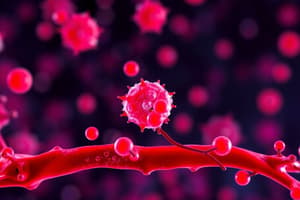Podcast
Questions and Answers
What is a common characteristic of Acquired Pure Red Cell Aplasia (PRCA)?
What is a common characteristic of Acquired Pure Red Cell Aplasia (PRCA)?
- Increased numbers of RBC precursors
- Alterations in all cell line precursors
- Severe increase in hemoglobin levels
- Normal WBC and platelet counts (correct)
Which treatment is typically administered to patients with Acquired PRCA?
Which treatment is typically administered to patients with Acquired PRCA?
- G-CSF
- RBC Transfusion (correct)
- Radiation therapy
- Pancreatic enzyme replacement
What laboratory finding is associated with Pure Red Cell Aplasia?
What laboratory finding is associated with Pure Red Cell Aplasia?
- Decreased platelet counts
- Elevated trypsin levels
- Increased WBC counts
- Normocytic RBCs which are decreased in numbers (correct)
Diamond-Blackfan anemia is classified as which type of disorder?
Diamond-Blackfan anemia is classified as which type of disorder?
What is one clinical finding associated with Diamond-Blackfan anemia?
What is one clinical finding associated with Diamond-Blackfan anemia?
Which of the following can be a cause of Secondary PRCA?
Which of the following can be a cause of Secondary PRCA?
What does the presence of hypocellular bone marrow indicate in a patient?
What does the presence of hypocellular bone marrow indicate in a patient?
Which statement about G-CSF in treating neutropenia is accurate?
Which statement about G-CSF in treating neutropenia is accurate?
What is a key laboratory finding in patients with acute acquired aplastic anemia?
What is a key laboratory finding in patients with acute acquired aplastic anemia?
Which treatment is preferred for patients with severe aplastic anemia under 40 years of age?
Which treatment is preferred for patients with severe aplastic anemia under 40 years of age?
Which symptom is associated with inherited Fanconi anemia?
Which symptom is associated with inherited Fanconi anemia?
What best describes the genetic cause of Fanconi anemia?
What best describes the genetic cause of Fanconi anemia?
Which laboratory finding is diagnostic for Fanconi anemia when a DNA-cross linking agent is added?
Which laboratory finding is diagnostic for Fanconi anemia when a DNA-cross linking agent is added?
Which feature is NOT typically associated with the laboratory findings of inherited aplastic anemia?
Which feature is NOT typically associated with the laboratory findings of inherited aplastic anemia?
Which treatment is deemed supportive for managing aplastic anemia?
Which treatment is deemed supportive for managing aplastic anemia?
What common finding in inherited aplastic anemia indicates susceptibility to chromosome breakage?
What common finding in inherited aplastic anemia indicates susceptibility to chromosome breakage?
What laboratory finding is NOT typically associated with myelophthisic anemia?
What laboratory finding is NOT typically associated with myelophthisic anemia?
Which treatment is least likely to be used for congenital dyserythropoietic anemia?
Which treatment is least likely to be used for congenital dyserythropoietic anemia?
Which condition is characterized by an infiltration of tumor cells into the bone marrow?
Which condition is characterized by an infiltration of tumor cells into the bone marrow?
What is a common clinical finding in anemia of chronic kidney disease?
What is a common clinical finding in anemia of chronic kidney disease?
Which of the following laboratory findings is characteristic of congenital dyserythropoietic anemia?
Which of the following laboratory findings is characteristic of congenital dyserythropoietic anemia?
Which treatment is NOT typically a part of managing myelophthisic anemia?
Which treatment is NOT typically a part of managing myelophthisic anemia?
Which form of anemia is characterized by reticulocytopenia and normal bone marrow cellularity?
Which form of anemia is characterized by reticulocytopenia and normal bone marrow cellularity?
Which of the following best describes the reticulocyte count in congenital dyserythropoietic anemia?
Which of the following best describes the reticulocyte count in congenital dyserythropoietic anemia?
Flashcards are hidden until you start studying
Study Notes
Lab Findings and Treatments
- Neutropenia can coexist with anemia or thrombocytopenia; not all patients exhibit this.
- Hypocellular bone marrow often found in affected individuals.
- Elevated fecal fat levels and low trypsin levels suggest malabsorption issues.
- Treatment options include G-CSF for neutropenia, transfusions for anemia or thrombocytopenia, and pancreatic enzyme replacement for fat malabsorption.
Other Forms of Bone Marrow Failure
-
Pure Red Cell Aplasia (PRCA):
- Rare disorder causing severe reduction in RBC precursors, sparing other cell lines.
- Clinical presentation includes decreased RBC counts with normal WBC and platelet counts.
- Can be acquired (idiopathic or secondary to drug exposure) or congenital, necessitating varying treatments.
-
Acquired PRCA:
- Can manifest acutely or chronically.
- Primary cases are often idiopathic or immunologic; secondary cases follow cancer or chemical exposure.
- Treatment includes IST with agents like Cyclosporine.
- In children, often linked to infections; termed transient erythroblastopenia of childhood (TEC).
-
Congenital PRCA:
- Example: Diamond-Blackfan anemia affecting 1 in 143,000 infants; mutations affect ribosome protein genes.
- Clinical features include craniofacial dysmorphism, short stature, and malformations in neck and thumbs.
Laboratory Findings
- Complete Blood Count (CBC):
- Pancytopenia, increased or normal MCV, decreased reticulocyte counts.
- Iron Studies:
- Elevated serum iron and transferrin saturation.
- Bone Marrow Examination:
- Prominent fat cells, severe hypocellularity, no blasts noted.
Treatment and Prognosis
- Identification and removal of offending agents are crucial.
- Blood transfusions may help maintain safe blood levels.
- Bone marrow transplantation preferred for severe aplastic anemia in individuals under 40; older patients may use antithymocyte globulin and cyclosporine.
- Antibiotics recommended to manage neutropenia.
Inherited Aplastic Anemia
- Early childhood manifestations with potential physical malformations.
- Fanconi Anemia:
- Features skeletal abnormalities, skin pigmentation, short stature, and organ malformations.
- An increase in tumor risk is associated with this condition.
Genetics and Pathophysiology
- Fanconi anemia results from mutations in 13 genes, primarily inherited in an autosomal recessive manner, except FANCB (X-linked).
- Cells show susceptibility to chromosome breakage, shortened telomeres, and dysregulation of cytokines.
Laboratory Findings in Inherited Aplastic Anemia
- Findings mirror acquired aplastic anemia with elevated HbF and Alpha-Fetoprotein.
- Characteristic chromosome breakage occurs upon exposure to DNA-cross-linking agents, aiding diagnosis.
Other Forms of Bone Marrow Failure
-
Congenital Dyserythropoietic Anemia:
- Characterized by refractory anemia, reticulocytopenia, and dysplastic erythroblasts with ineffective erythropoiesis.
- Treatment may include splenectomy and iron depletion, tailored to the specific type.
-
Myelophthisic Anemia:
- Infiltration by abnormal cells disrupts normal bone marrow function, often leading to extramedullary hematopoiesis.
- Common infiltrating agents include tumor cells and leukemic cells.
Findings and Treatment for Myelophthisic Anemia
- Presents with mild to moderate anemia, reticulocytopenia, teardrop cells, nucleated RBCs, and leukoerythroblastosis.
- Treatment focuses on addressing the underlying condition and possible bone marrow replacement.
Anemia of Chronic Kidney Disease
- Inadequate erythropoietin production due to dysfunctional kidneys leads to anemia.
- Uremic toxins may inhibit erythropoiesis and decrease RBC lifespan.
- Consequences of dialysis may include chronic blood loss and associated iron deficiency.
Studying That Suits You
Use AI to generate personalized quizzes and flashcards to suit your learning preferences.




